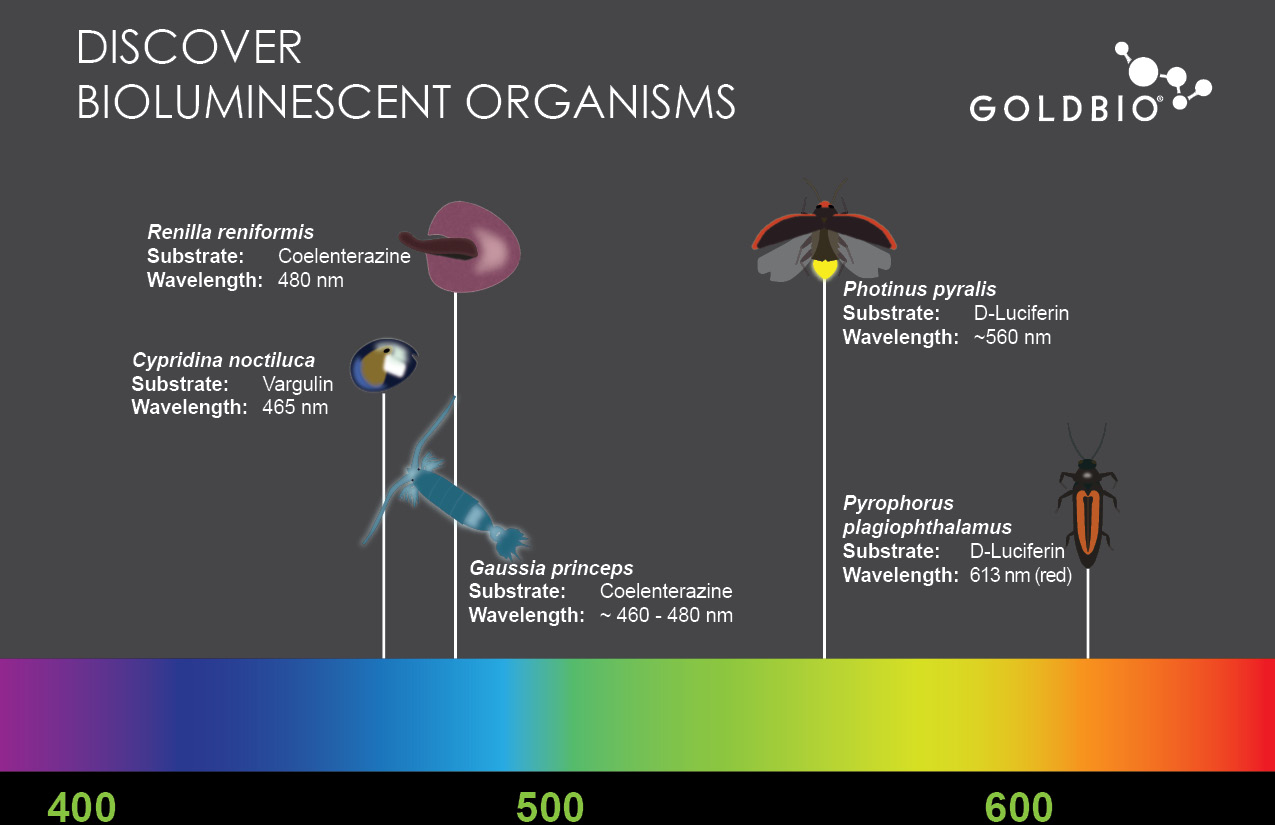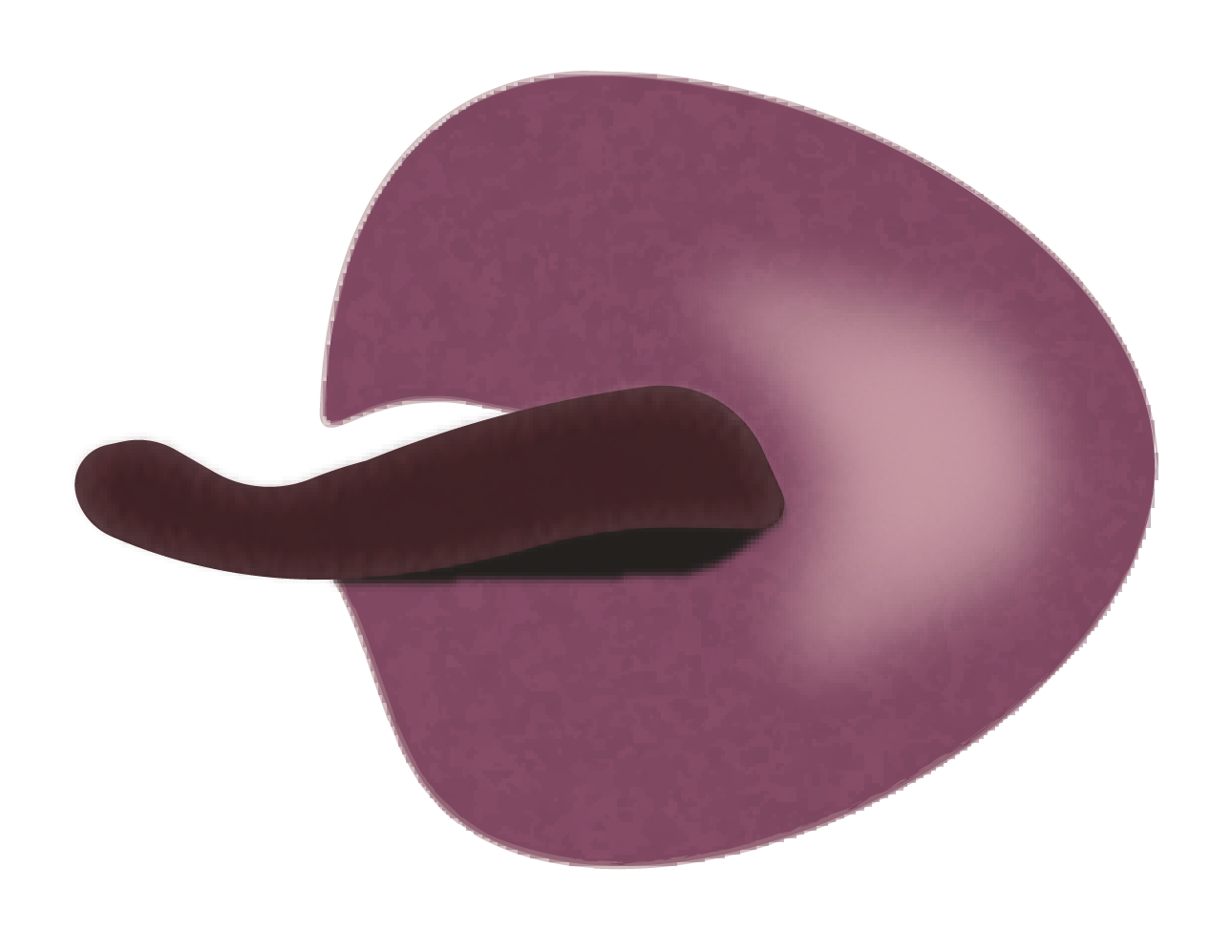How Different Luciferin-Luciferase Systems Are Used In Biotechnology
by Katharine Martin

by Katharine Martin
resently, bioluminescence remains a source of inspiration and mysticism, but within biotechnology, bioluminescence is a powerful tool. In this article, we briefly examine different bioluminescent systems and their general use within biotechnology.
Bioluminescent assays have several advantages. While fluorescent assays might be more popular, bioluminescence doesn’t produce as much background signal since it doesn’t require excitation light energy (Thorne, Inglese, & Auld, 2010).

IMAGE | Bioluminescent Reaction vs. Fluorescent Reaction: Bioluminescence is a chemical reaction that occurs naturally within living organisms. In this example the binding of the substrate luciferin and oxygen is catalyzed by the enzyme luciferase to produce oxyluciferin and light. In fluorescence, light of a higher energy (shorter wavelength) is absorbed. Light is then emitted at a lower energy than what was originally absorbed. Fluorescence produces intense, bright light. However, bioluminescence offers higher signal-noise ratio and does not require initial light for excitation.
Different bioluminescent systems are dependent on specific types of bioluminescent substrates. For instance, firefly and click beetle luciferases are dependent on d-luciferin. Gaussia, and Renilla luciferases are dependent on coelenterazine. These different systems and their associated substrate offer different advantages within biotechnology, making them suited for specific studies.
Uses of Coelenterazine Dependent Luciferase Systems
Renilla (Sea Pansy) Luciferase:
Gaussia (Copepod crustacean) Luciferase:
Uses of Vargulin (Cypridina Luciferin) Dependent Luciferase Systems
Cypridina (Ostracodcrustacean) Luciferase:
Uses of D-Luciferin Dependent Luciferase Systems


Renilla luciferase (RLuc) is a popular reporter from Renilla reniformis, or the sea pansy. The RLuc gene can be expressed in mammalian cells and is used in a dual reporter system alongside firefly luciferase as an internal control (Burbelo, Kisailus, Peck, 2002).
A dual bioluminescent assay using Renilla and firefly luciferase is possible due to their enzymatic and substrate differences. Emission for each reaction is substantially different, making it easy to distinguish between the two.
The dual reporter system is used for quantifying gene expression. Within the same system, each luciferase is measured for activity. The goal of a dual-luciferase® reporter system is to ensure assay accuracy and reproducibility (McNabb, Reed & Marciniak, 2005). During experimentation, firefly luciferase is often used as the experimental reporter while Renilla luciferase acts as the control reporter.
 Gaussia luciferase (GLuc) comes from the copepod Gaussia princeps. When it comes to luciferases, Gaussia luciferase is a newer player; however, it comes with several advantages since it is a naturally secreted protein. These advantages include high thermostability, high catalysis, high sensitivity, and small size.
Gaussia luciferase (GLuc) comes from the copepod Gaussia princeps. When it comes to luciferases, Gaussia luciferase is a newer player; however, it comes with several advantages since it is a naturally secreted protein. These advantages include high thermostability, high catalysis, high sensitivity, and small size.
Because of these advantages, Gaussia luciferase has been used to study cellular secretory pathways, biological processes in cultured cells, and tumor progression (Fleiss & Sarkisyan, 2019), (Tannous, 2009). In contrast to intracellular luciferases, naturally secreted Gaussia luciferase (GLuc) enables repeated, non-destructive analysis of the same living cells, as GLuc is continuously secreted into the culture medium and can be measured there without cell lysis (Wider, Picard, 2017).
One thing to note, however, is that the Gaussia luciferase system can sometimes be challenging to work with. It becomes less challenging to use when working with a cell line with high transfection efficiency.

Cypridina luciferase (CLuc) is not as widely used. However, like Gaussia luciferase, Cypridina luciferase is also a naturally secreted protein. Because Cypridina luciferase depends on a completely different substrate, vargulin (Cypridina luciferin), it can be used in dual reporter assays.
Its activity can be measured both in living mammalian cells and in cell lysates.
Advantages of Cypridina luciferase include its overall stability, thermostability, sensitivity, ease of use and natural secretion making it useful in live cells.
Cypridina luciferase has been used in circadian rhythm studies, bioimaging and in immunoassays (Fleiss & Sarkisyan, 2019).
D-luciferin dependent bioluminescent systems are the mostly widely studied. This system includes fireflies and click beetles.

Firefly luciferase is the most widely used luciferase system within biotechnology (Xu et al., 2016). Its popularity stems from its early discovery, high sensitivity, ease of use, and thermostability. Another advantage of firefly luciferase is that, compared to many chemical assays, the enzyme and its substrates are generally considered to present lower biological hazard, although care should be taken with some commercial assay reagents.
This versatile system has been used for in vitro and in vivo systems to study protein-protein interactions, protein-ligand interactions, cell communication and signaling, and more (Fleiss & Sarkisyan, 2019).
The firefly luciferase assay itself is extremely user friendly, where cell extracts are mixed into the assay solution and then measured with a luminometer. It is also reported that immunohistochemistry, activity can be detected in situ. The firefly luciferase assay has been been very important to in vivo mouse, plant and tissue studies of gene expression (Howell, Ow, Schneider, 1989).
Firefly luciferase has inspired plant engineering projects where plants might glow using the bioluminescent reaction. However, there has been a lot of difficulty in implementation and the amount of glow achieved is not significant enough.
To enhance bioluminescent imaging, modified firefly luciferases have been engineered for better spectral characteristics and increased stability. One example of modification is red-shifted luciferase, which offers an advantage in vivo (Dorsaz, Coste, & Sanglard, 2017).
Detection sensitivity in mammalian tissue is impacted by light absorption and scattering. Both of these factors can reduce overall sensitivity. Light scattering is not easily controlled since it’s mainly caused by tissue makeup. However luciferase modifications that increase wavelength over 600 nm have reduced absorption issues and enabled greater sensitivity (Miloud, Henrich & Hammerling, 2007).

Click beetle (Pyrophorus plagiophthalamus) is also a popularly used luciferase system. Like firefly luciferase, click beetle luciferase uses d-luciferin as its substrate.
Advantages of click beetle luciferase include wide pH range tolerance, color variability (green, red) and stability.
Another major draw to click beetle luciferase has to do particularly with red click beetle luciferase. Red light emission is ideal for deep tissue penetration. Hemoglobin, for example, absorbs green and blue light emitted. This absorption greatly reduces BLI sensitivity. However, this absorption becomes reduced in tissues when wavelengths are in excess of 600 nm. Therefore, the 613 nm red click beetle luciferase becomes an extremely valuable imaging tool (Miloud, Henrich & Hammerling, 2007).
Branchini, B., Southworth, T., Fontaine, D., Kohrt, D., Florentine, C., & Grossel, M. (2018, April 16). A Firefly Luciferase Dual Color Bioluminescence Reporter Assay Using Two Substrates To Simultaneously Monitor Two Gene Expression Events. Retrieved September 11, 2020, from https://www.nature.com/articles/s41598-018-24278-2
Brock, M. (2011). Application of Bioluminescence Imaging for In Vivo Monitoring of Fungal Infections. International Journal of Microbiology, 2012. Retrieved September 11, 2020, from https://www.hindawi.com/journals/ijmicro/2012/956794/
Burbelo, P. D., Kisailus, A. E., & Peck, J. W. (2002). Detecting Protein-Protein Interactions Using Renilla Luciferase Fusion Proteins. BioTechniques, 33(5), 1044-1050. doi:10.2144/02335st05
Dorsaz, S., Coste, A., & Sanglard, D. (2017, July 21). Red-Shifted Firefly Luciferase Optimized for Candida albicans In vivo Bioluminescence Imaging. Retrieved September 11, 2020, from https://www.frontiersin.org/articles/10.3389/fmicb.2017.01478/full
Fleiss, A., & Sarkisyan, K. (2019, March 8). A brief review of bioluminescent systems. Retrieved September 11, 2020, from https://link.springer.com/article/10.1007/s00294-019-00951-5
Howell, S., Ow, D., & Schneider, M. (1989, January 01). Use of the firefly luciferase gene as a reporter of gene expression in plants. Retrieved September 11, 2020, from https://link.springer.com/chapter/10.1007/978-94-009-0951-9_18
Luker, G., & Luker, K. (2011, June 15). Luciferase protein complementation assays for bioluminescence imaging of cells and mice. Retrieved September 11, 2020, from https://www.ncbi.nlm.nih.gov/pmc/articles/PMC4467521/
Magalhães, C., Silva, J., & Silva, L. (2018, November 13). Comparative study of the chemiluminescence of coelenterazine, coelenterazine-e and Cypridina luciferin with an experimental and theoretical approach. Retrieved September 11, 2020, from https://www.sciencedirect.com/science/article/abs/pii/S1011134418308327
Miloud, T., Henrich, C., & Hammerling, G. (2007, September 1). Quantitative comparison of click beetle and firefly luciferases for in vivo bioluminescence imaging. Retrieved September 11, 2020, from https://www.spiedigitallibrary.org/journals/journal-of-biomedical-optics/volume-12/issue-5/054018/Quantitative-comparison-of-click-beetle-and-firefly-luciferases-for-in/10.1117/1.2800386.full?SSO=1
Noguchi, T., & Golden, S. (n.d.). Bioluminescent and fluorescent reporters in circadian rhythm studies. Retrieved September 11, 2020, from https://ccb.ucsd.edu/the-bioclock-studio/education-resources/reporter-review/ReporterReviewPDF.pdf
Remy, I., & Michnick, S. (2006, December). A highly sensitive proteinprotein interaction assay based on Gaussia luciferase. Retrieved September 11, 2020, from https://www.researchgate.net/profile/Stephen_Michnick/publication/6697246_A_highly_sensitive_protein-protein_interaction_assay_based_on_Gaussia_luciferase/links/5469bb040cf20dedafd0efff/A-highly-sensitive-protein-protein-interaction-assay-based-on-Gaussia-luciferase.pdf
Tannous, B. (2009, July 1). Gaussia luciferase reporter assay for monitoring biological processes in culture and in vivo. Retrieved September 11, 2020, from https://www.ncbi.nlm.nih.gov/pmc/articles/PMC2692611/
Thorne, N., Inglese, J., & Auld, D. (2010, June 25). Illuminating insights into firefly luciferase and other bioluminescent reporters used in chemical biology. Retrieved September 11, 2020, from https://www.ncbi.nlm.nih.gov/pmc/articles/PMC2925662/
Thorne, N., Inglese, J., & Auld, D. (2010, June 25). Illuminating insights into firefly luciferase and other bioluminescent reporters used in chemical biology. Retrieved September 11, 2020, from https://www.ncbi.nlm.nih.gov/pmc/articles/PMC2925662/
Wider, D., & Picard, D. (2017, December 8). Secreted dual reporter assay with Gaussia luciferase and the red fluorescent protein mCherry. Retrieved September 11, 2020, from https://journals.plos.org/plosone/article?id=10.1371%2Fjournal.pone.0189403
Xu, T., Close, D., Handagama, W., Marr, E., Sayler, G., & Ripp, S. (2016, June 01). The Expanding Toolbox of In Vivo Bioluminescent Imaging. Retrieved September 11, 2020, from https://www.frontiersin.org/articles/10.3389/fonc.2016.00150/full
Xu, T., Close, D., Handagama, W., Marr, E., Sayler, G., & Ripp, S. (2016, June 01). The Expanding Toolbox of In Vivo Bioluminescent Imaging. Retrieved September 11, 2020, from https://www.frontiersin.org/articles/10.3389/fonc.2016.00150/full

IPTG and auto-induction are two ways to induce protein expression in bacteria. They work similarly, but have different trade-offs in terms of convenience. While IPTG...

The final concentration of IPTG used for induction varies from 0.1 to 1.0 mM, with 0.5 or 1.0 mM most frequently used. For proteins with...

A His-tag is a stretch of 6-10 histidine amino acids in a row that is used for affinity purification, protein detection, and biochemical assays. His-tags...

Competent cells such as DH5a, DH10B, and BL21 will maintain their transformation efficiency for at least a year with proper storage. It is important to...
